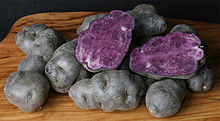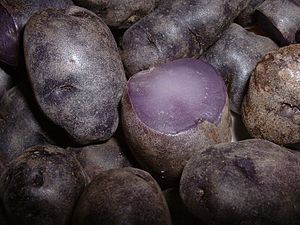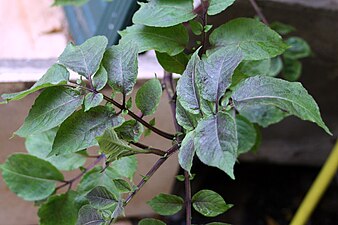'Vitelotte', also called Vitelotte noire, Négresse[1]: 150 or Truffe de Chine,[2] is a gourmet French variety of blue-violet potato.[3] It has been cultivated in France at least since the early nineteenth century.
| Potato 'Vitelotte' | |
|---|---|
 'Vitelotte' potatoes | |
| Genus | Solanum |
| Species | Solanum tuberosum |
| Cultivar | 'Vitelotte' |
| Origin | France |
Description
'Vitelotte' potatoes have a dark blue, almost black, skin and dark violet-blue flesh; they have a characteristic nutty flavour and smell of chestnuts. The colour is retained in cooking, and is due to natural pigments in the anthocyanin group of flavonoids.[4] The plants mature late and, compared to modern varieties, are relatively low-yielding. The tubers are elongated with sunken eyes;[2] they are thick-skinned, and thus keep well.
Etymology
The French word vitelotte derives from the archaic French: vit, meaning "penis" (modern French bite), by analogy with the shape of the tuber. The first occurrence of the word is from 1812.[5]
History
In early descriptions, vitelotte were not necessarily violet-coloured. In a source from 1817, six varieties of potato are listed as available at the market of Les Halles; among them are both vitelotte and violette ("violet").[6]: 508 A treatise on agriculture published in 1863 lists five possible colours for the vitelotte: white, yellow, pink, red and violet.[7] In 1873 Alexandre Dumas wrote in his Grand dictionnaire de cuisine:[8]: 847
"... the best of all are unquestionably the violet [ones], preferable even to the red [ones], [and] known in Paris by the name of Vitelottes'".
Gallery
- Whole and halved
- As potato crisps
- Leaves and stalks showing violet colouring
References




